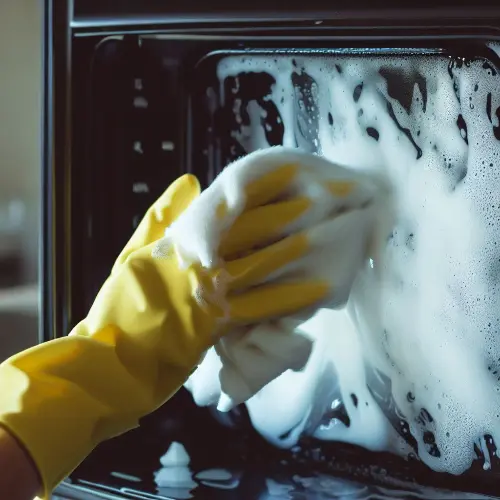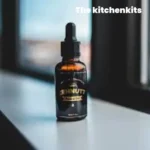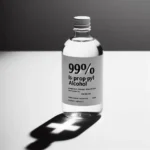Table of Contents
Can You Clean A Microwave With Bleach?
A microwave oven is one of the most used appliances in any kitchen. It provides a quick and convenient way to heat up or cook food. However, microwaves can get dirty quickly, like any frequently used appliance. Food splatters, grease, and grime can build up on the interior walls, turning your microwave into an unsightly mess.
When it’s time to clean your microwave, you may be tempted to reach for the bottle of bleach, thinking it will sanitize and disinfect the appliance. But is using bleach to clean a microwave safe and effective? Let’s dive into anything you need about cleaning a microwave with bleach.
Should You Use Bleach to Clean a Microwave?
Bleach is a commonly used household cleaner known for its ability to disinfect, sanitize, and remove tough stains. However, most appliance manufacturers strongly advise against using bleach or harsh chemicals to clean your microwave.
Here are some key reasons why bleach isn’t recommended:
- Bleach can damage the interior – The inside of the microwave often has a protective coating that could get damaged by prolonged contact with harsh cleaners like bleach. This can lead to corrosion over time.
- It does not effectively clean – While sanitizing bleach, it does not break down and dissolve baked-on grease and food residue. So it does not thoroughly clean a microwave.
- Bleach fumes are unsafe – When heated, bleach releases toxic chlorine gas, which should not be inhaled. The confined space of a microwave oven makes this an unsafe practice.
- It can ruin food – Any residual bleach left behind can get into food cooked in the microwave. This could negatively impact the taste and make the food unsafe for consumption.
For these reasons, appliance makers strongly caution against using bleach or bleach products to clean your microwave.
Safe Alternatives to Clean a Microwave with Bleach
Luckily, there are several safer, more effective options for tackling even the toughest built-up grime and stains inside a microwave. Here are some of the best cleaning tips and microwave cleaners to use instead of bleach:
Vinegar
- White vinegar is a natural degreaser and cleaning agent that can dissolve caked-on food and lift stains. To use it:
- Place a bowl of white vinegar in the microwave and heat for 2-3 minutes until boiling. This will loosen grime.
- Let the vinegar sit in the closed microwave for a few minutes to soften baked-on messes.
- Use a non-abrasive sponge or cloth dipped in vinegar to wipe down the interior.
- For tough stains, make a paste with baking soda and vinegar and let it set before scrubbing.
Lemon Juice
Like vinegar, lemon juice can cut through grease and grime without harsh chemicals. Try microwaving a bowl of lemon juice to loosen dirt before wiping it down with a soft sponge or cloth.
Mild Dish Soap
Mix a couple of tablespoons of mild dish soap with warm water in a spray bottle for a basic cleaning solution. Spray inside the microwave, then wipe clean with a soft cloth, repeating for tough spots. Avoid using ultra-concentrated detergents.
Baking Soda
Baking soda works well to absorb odors and neutralize stains in the microwave. Make a paste with water and gently scrub the interior with a soft cloth. You can also place a bowl of baking soda inside and microwave for 1-2 minutes to freshen the appliance.
Steam Clean
Heat a bowl of water until boiling to generate steam inside your microwave. The steam will naturally loosen any food buildup. Carefully remove the hot bowl and use a cloth to wipe away grime.
Tips for Cleaning a Microwave with Bleach
While not generally recommended, there may be instances where you need an aggressive cleaner like bleach to tackle stubborn stains or buildup that other methods cannot remove. Here are some tips to follow if you must use bleach in your microwave:
- Make sure it’s diluted – Only use a bleach and water solution of 1 part bleach to 10 parts water. This reduces the concentration.
- Apply carefully – Use a clean sponge or cloth to apply the diluted solution directly to stained areas. Avoid spraying or pouring directly, as the bleach could seep into crevices.
- Limit contact time – Let the bleach sit for no more than 1-2 minutes before wiping to avoid damage. Don’t let puddles pool.
- Rinse and ventilate – After wiping down the interior, thoroughly rinse with clean water and a damp sponge to eliminate bleach residue. Leave the door open to air out and dry thoroughly.
- Test on inconspicuous spots first – Try a hidden spot like the top or side before applying to visible surfaces so you can assess if any damage occurs.
- Never mix with other cleaners – Bleach mixed with vinegar, ammonia, or other acids creates toxic fumes.
- Avoid heating bleach – Do not run the microwave with bleach solution inside.
Even diluted bleach is a powerful chemical and must be handled cautiously inside your microwave. Make sure to take all precautions.
FAQ
Can you clean a microwave with bleach?
It is best to avoid using bleach to clean the inside of your microwave. Bleach is an ordinary cleaner, but it is not recommended for cleaning kitchen appliances like microwaves.
What is the best way to clean a microwave?
The best way to clean a microwave is to use a microwave-safe bowl filled with one cup of water and a few tablespoons of vinegar. Place the bowl in the microwave and heat it on high for a few minutes until the water boils and creates steam. Then, wipe down the inside of your microwave with a damp cloth or some paper towels.
Is it dangerous to clean a microwave?
Cleaning a microwave can be tricky, but it is safe if done correctly. However, using bleach or other harsh chemicals can be hazardous. It is essential to follow safe cleaning tips and avoid using cleaning products that may cause harm or leave harmful residues in your microwave.
How often should I clean my microwave?
It is a good idea to clean your microwave regularly, mainly if you use it frequently. A deep clean every few weeks is recommended, but you can also wipe down the inside of your microwave with a damp cloth or paper towel after each use to keep it clean.
Can I use soap and water to clean my microwave?
Yes, using a solution of warm, soapy water is a safe and effective way to clean the inside of your microwave. Dip a cloth or sponge in the soapy water, wring out excess moisture, and wipe down the interior surfaces of your microwave.
How can I safely clean a microwave?
To safely clean your microwave, avoid using abrasive cleaners or scrubbing pads that may scratch the interior. Instead, use a soft cloth or sponge and a mild cleaning solution like warm, soapy water or a vinegar-water mixture. Always unplug the microwave before cleaning, and remove any spills or food particles.
Can I use Clorox to clean my microwave?
It is best to avoid using bleach, such as Clorox, to clean the inside of your microwave. Bleach is highly concentrated and can leave harmful residue or emit toxic fumes when heated in the microwave. Stick to safer and more gentle cleaning methods.
How do I remove tough stains from the microwave?
If you have stubborn stains inside your microwave, try using a paste made from baking soda and water. Apply the paste to the stained areas, let it sit for a few minutes, then wipe it away with a damp cloth or sponge. Repeat as necessary until the stains are removed.
Is it safe to use a microwave after cleaning it?
Yes, it is safe to use your microwave after cleaning it. Remove any cleaning agents or residue from the interior surfaces before using the microwave again. You can do this by wiping the inside with a clean, damp cloth or paper towel.
How do I clean the outside of my microwave?
To clean the outside of your microwave, wipe it down with a damp cloth or sponge and a mild cleaning solution. Avoid using abrasive cleaners or harsh chemicals that may damage the surface of your microwave.
Conclusion
While using bleach to clean a microwave may seem like a shortcut to removing tough stains, it’s an unsafe practice that can cause more harm than good. For the most thorough clean without damage, stick to mild cleaners like dish soap, vinegar, and baking soda applied with non-abrasive scrubbing. Target grease and food buildup first before disinfecting and deodorizing the appliance.
You can keep your microwave clean and hygienic without harsh chemicals like bleach with the proper methods and a little elbow grease. Taking the time to clean it regularly will also help prevent significant buildup. Your microwave will sparkle like new!

I’m Ian Welkins, a seasoned professional in the kitchen industry. My passion now drives me to provide invaluable insights into the world of top-notch kitchen products. With years of hands-on experience, I’m your go-to source for culinary excellence.











